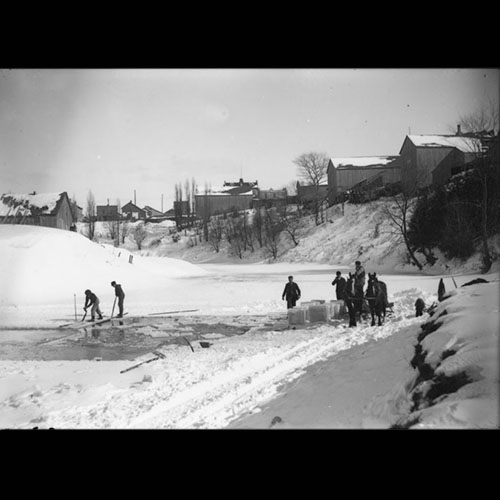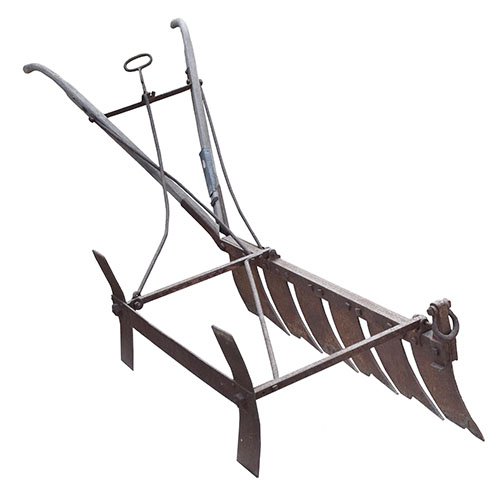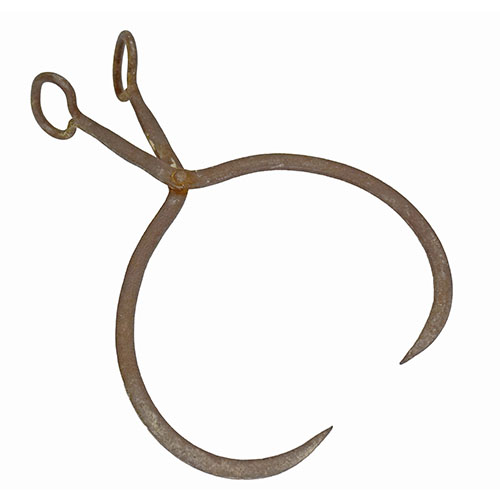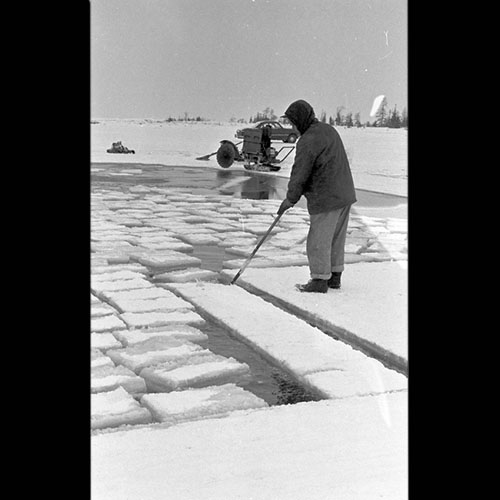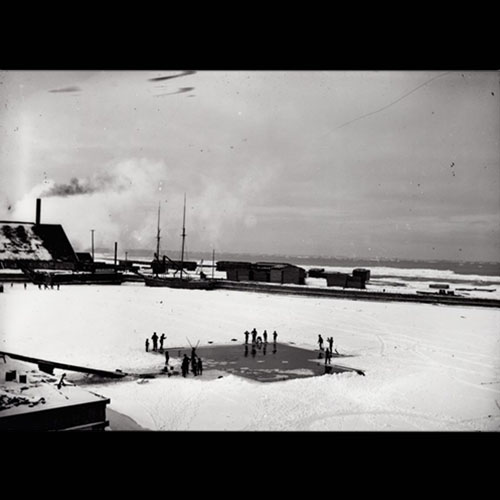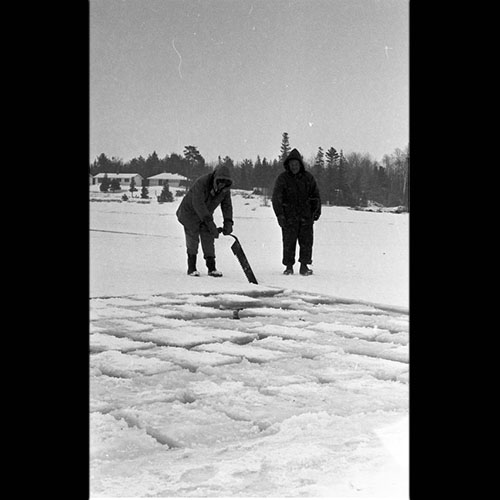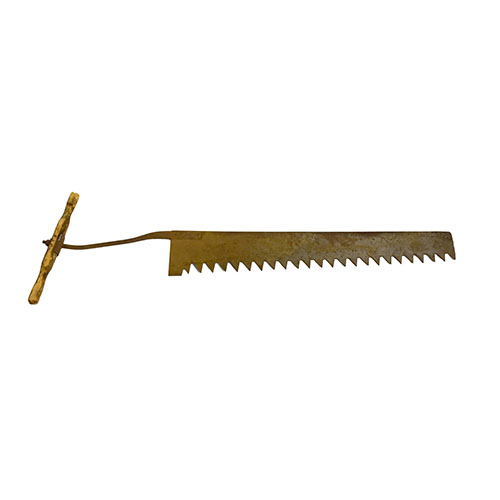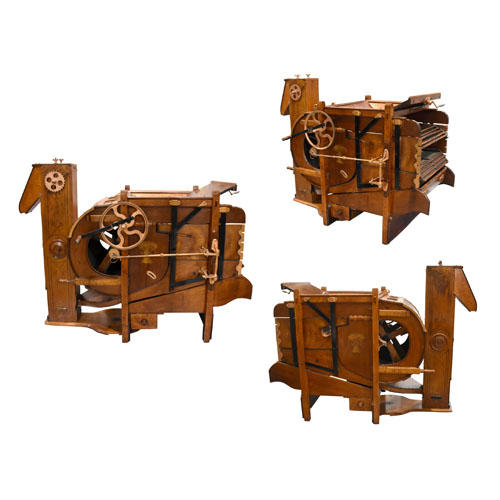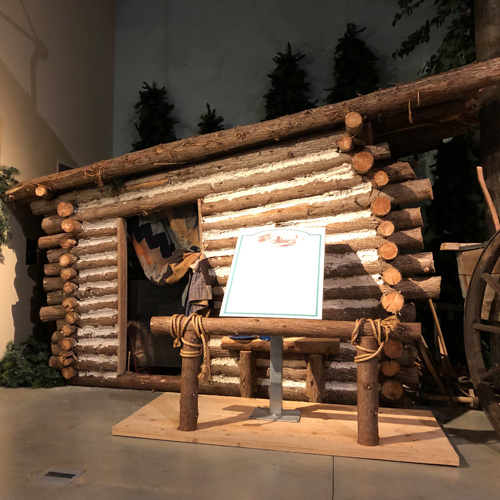The winter months brought a different type of harvest season to Bruce County. Before refrigerators and electricity were readily available, individuals had to be resourceful in keeping food, milk and other perishables stored safely for when the summer months approached. This seasonal industry would supply large blocks of ice for many individuals and businesses to store in their ice houses or ice boxes. The Canadian Pacific Railway used the blocks in their refrigeration cars. Fisheries, butchers, creameries, grocery stores and hotels are some of the businesses who relied on a bountiful harvest.
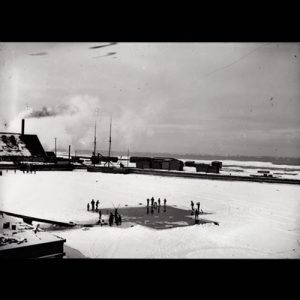 The ice harvest would typically be done in February with some seasons extending into March depending on the temperatures. The ice would need to reach a certain thickness and quality to ensure it would last. The ice would be cut into square blocks and would range from 12-18 inches thick and weighing between 200-300 pounds. The best quality of ice came from the freshwater lakes and would have a blue like appearance. Not harvesting the ice in time would risk more of a cloudy appearance which was caused by a combination of melting and snow mixed in. The unpredictable winter weather would play a factor in the season’s success. Bouts of warm temperatures put the ice quality at risk, along with the worker’s lives. It was a dangerous job, and men and horses would fall in the freezing waters and not survive.
The ice harvest would typically be done in February with some seasons extending into March depending on the temperatures. The ice would need to reach a certain thickness and quality to ensure it would last. The ice would be cut into square blocks and would range from 12-18 inches thick and weighing between 200-300 pounds. The best quality of ice came from the freshwater lakes and would have a blue like appearance. Not harvesting the ice in time would risk more of a cloudy appearance which was caused by a combination of melting and snow mixed in. The unpredictable winter weather would play a factor in the season’s success. Bouts of warm temperatures put the ice quality at risk, along with the worker’s lives. It was a dangerous job, and men and horses would fall in the freezing waters and not survive.
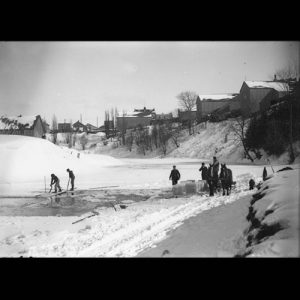 In the earlier days there would be a group of men with a team of horses and sleighs. Each would have the task to either cut the blocks, fish them in the open water and move towards the loading platforms, or physically lift the blocks and stack them for transporting and storage. By the late 1920’s, motorized cutting machines made the process faster and were able to produce large quantities of ice. A power saw could cut up to 3,000 blocks a day.
In the earlier days there would be a group of men with a team of horses and sleighs. Each would have the task to either cut the blocks, fish them in the open water and move towards the loading platforms, or physically lift the blocks and stack them for transporting and storage. By the late 1920’s, motorized cutting machines made the process faster and were able to produce large quantities of ice. A power saw could cut up to 3,000 blocks a day.
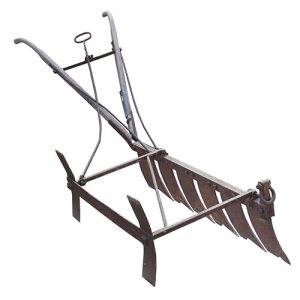 There were tried-and-true methods to get the job done fast and effectively. Earlier tools included scrapers for the ice surface, ice pike poles, an ice plow and handheld saw. The top of the ice needed to be scrapped off which removed the porous surface and simplified the cutting of the ice. The ice plow would score the ice surface into a grid pattern to mark the shape of the blocks. It was best to cut the ice the day before storing it so a good quantity of ice blocks would be readily available to start the storage process. If the weather was clear, the ice blocks could be left in the open water until later in the evening before they would start to refreeze.
There were tried-and-true methods to get the job done fast and effectively. Earlier tools included scrapers for the ice surface, ice pike poles, an ice plow and handheld saw. The top of the ice needed to be scrapped off which removed the porous surface and simplified the cutting of the ice. The ice plow would score the ice surface into a grid pattern to mark the shape of the blocks. It was best to cut the ice the day before storing it so a good quantity of ice blocks would be readily available to start the storage process. If the weather was clear, the ice blocks could be left in the open water until later in the evening before they would start to refreeze.
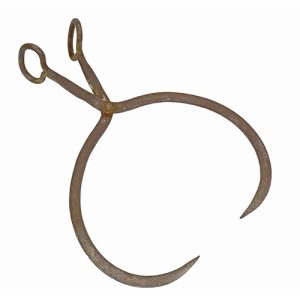 Packing and storage techniques were key to the longevity of the ice block. Using chutes to aid the blocks from sleigh to icehouse was easier on the men who physically moved them by hand. When steam or gasoline engines were available, a mechanized elevator system aided in hauling several blocks to transport. In the large ice houses, men would hang a rope over the rafters with a pair of ice tongs on the end. This method allowed for large quantities of blocks to be stacked. The ice tongs would need to be sharp to prevent any accidental drops onto the floor or on the men. Some harvested for their own personal use while others hired workers to harvest for their business. These workers would take the ice blocks to store at company’s ice houses and deliver the blocks in the summer months to residents or other businesses in need.
Packing and storage techniques were key to the longevity of the ice block. Using chutes to aid the blocks from sleigh to icehouse was easier on the men who physically moved them by hand. When steam or gasoline engines were available, a mechanized elevator system aided in hauling several blocks to transport. In the large ice houses, men would hang a rope over the rafters with a pair of ice tongs on the end. This method allowed for large quantities of blocks to be stacked. The ice tongs would need to be sharp to prevent any accidental drops onto the floor or on the men. Some harvested for their own personal use while others hired workers to harvest for their business. These workers would take the ice blocks to store at company’s ice houses and deliver the blocks in the summer months to residents or other businesses in need.
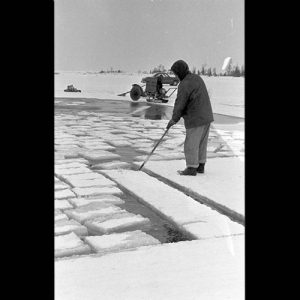 The icehouse needed to be well insulated to protect the ice from heat. It would need to be built in a dry area with tight fitting walls and a floor drain. Sawdust was used to pack in between blocks and against the walls to prevent the ice from melting at a fast rate. Leaving 12-14 inches in between the blocks and wall allowed for the most usage of space. Tar paper could be tacked onto the walls as another option of insulation. Once the ice blocks were stacked and gaps were filled in with broken or shaved pieces, water was poured over the ice to make it a solid mass. A thick layer of saw dust or clover chaff at the top of the ice mass would protect it from the rising heat. A ventilator at the top of the roof could aid in air circulation to help keep the ice block longer. A well-maintained icehouse could keep ice for up to a year until the next harvest season.
The icehouse needed to be well insulated to protect the ice from heat. It would need to be built in a dry area with tight fitting walls and a floor drain. Sawdust was used to pack in between blocks and against the walls to prevent the ice from melting at a fast rate. Leaving 12-14 inches in between the blocks and wall allowed for the most usage of space. Tar paper could be tacked onto the walls as another option of insulation. Once the ice blocks were stacked and gaps were filled in with broken or shaved pieces, water was poured over the ice to make it a solid mass. A thick layer of saw dust or clover chaff at the top of the ice mass would protect it from the rising heat. A ventilator at the top of the roof could aid in air circulation to help keep the ice block longer. A well-maintained icehouse could keep ice for up to a year until the next harvest season.
With the advancements in technology, ingenuity helped to develop other ways to create ice at a faster rate. In Kincardine, an ice plant was built during the winter of 1932. Three businessmen realized that cutting ice from the lake was not sufficient enough to supply all the businesses, ice houses and ice boxes. They developed the ice plant to create large quantities of ice; up to seven- and one-half tons of ice per day. As demand grew, the plant built an addition that provided 400 rental lockers and an area for cutting and wrapping meat. The plant closed in 1976.
Eventually the ice harvest industry faded as refrigerators were a common household accessory around the 1940’s, even though some rural farms and households relied on the use of ice houses and ice boxes much later into the 1950’s. The use of ice became more novelty over function as it became more readily available.
Sources:
Brown, Larry. Ice Harvesting [Photograph]. 1950-1959. A994.002.001 (01-010). Bruce County Museum & Cultural Centre
Brown, Larry. Ice Harvesting [Photograph]. 1950-1959. A994.002.001-04. Bruce County Museum & Cultural Centre
Scougall, John H. Men cutting ice, Penetangore River, Kincardine [Photograph]. 1874-1922. John. H. Scougall Fonds. A992.022.0230, Bruce County Museum & Cultural Centre
Scougall, John H. Cutting ice blocks in Kincardine harbour [Photograph]. 1874-1922. John. H. Scougall Fonds. A992.022.0957, Bruce County Museum & Cultural Centre
Cappel, Matthew. “Harvesting Ice in Bruce County.” Southampton: Bruce County Historical Yearbook, 2010.
Culross Historical Society. “All Our Yesterdays, A History of Culross Township 1854-1984.” Culross Historical Society, 1984. Print.
National Museum of American History. https://americanhistory.si.edu/blog/ice-harvesting-electric-refrigeration, retrieved 2/27/2023
Ice Harvesting in the 19th and Early 20th Century Ontario by Amy Scott. https://culinaryhistorians.ca/newsletters/CC_35.pdf, retrieved 2/28/2023
Gage, Earl W. “Co-Operation In Cutting Ice”, Paisley Advocate, 13 February 1918.
The Chesley Enterprise, March 11, 1920, Vol. 44 No. 7
The Chesley Enterprise February 10, 1927, Vol. 50 No. 51.
The Chesley Enterprise, February 20, 1930, Vol. 52 No. 49
The Walkerton Herald-Times, January 27, 1930, Vol. 70 No. 4

